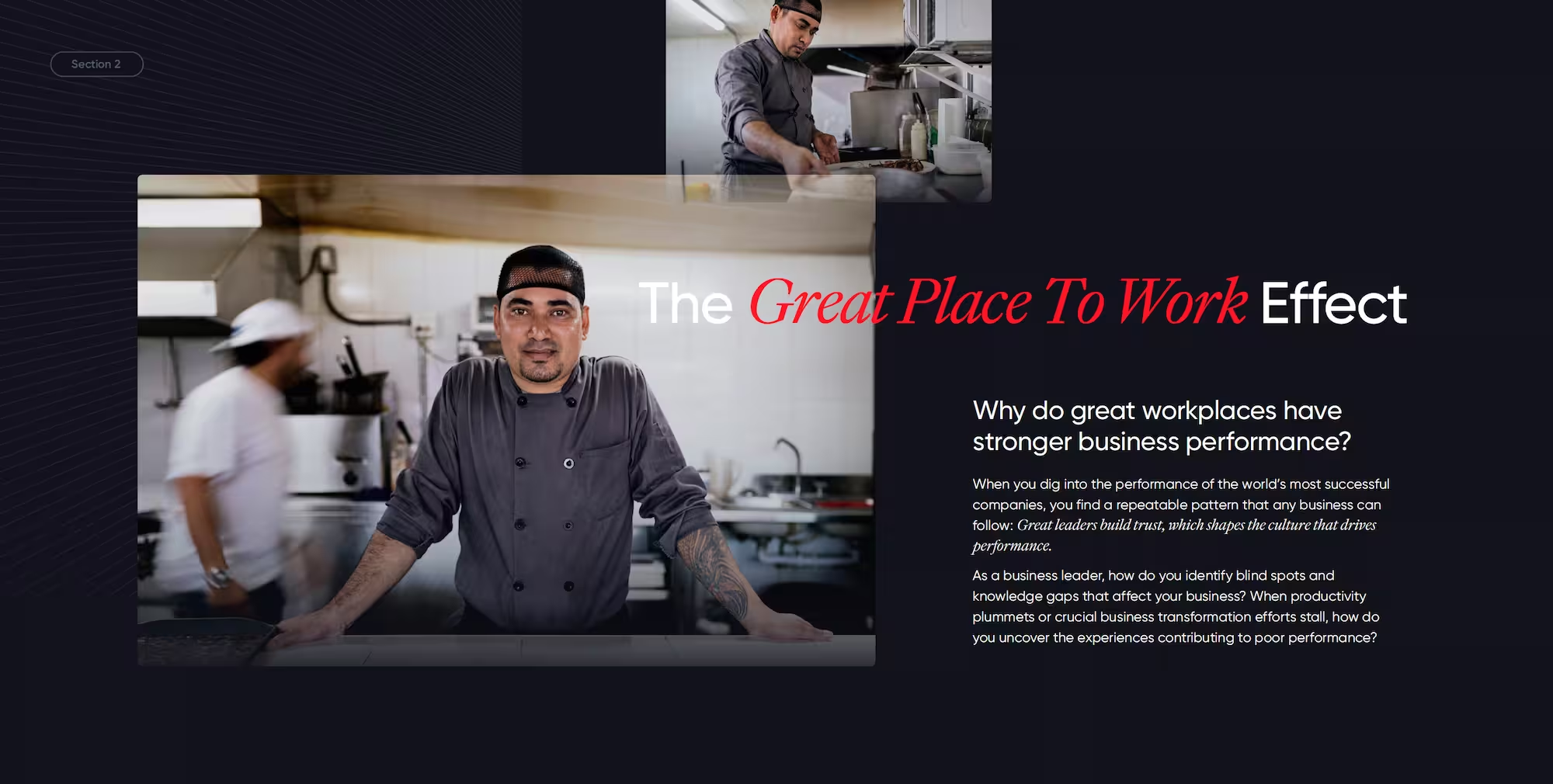
Artificial Intelligence (AI), Start-ups
Key Takeaways:
- Trust as the Core of AI Success: Organizations with high employee trust experience 8.5x higher revenue per employee and 3.5x stronger market performance, proving that transparent AI adoption is directly linked to trust-driven growth.
- Companies that involve employees in AI integration report 81% adaptability and double the innovation ratio compared to typical workplaces.
- Human-Centered AI Strategy: Balancing tech efficiency with ethical communication ensures that employees see AI as an enabler, not a threat — fostering long-term cultural resilience and collaboration.
- Trust Index™ as a Predictive Metric: Using tools like the Great Place To Work Trust Index™, leaders can measure trust as a KPI that forecasts agility, innovation, productivity, and overall readiness for AI transformation.
Startups are innovative. They are agile. They are known for their tight-knit, enthusiastic teams drawn together by a shared purpose. As artificial intelligence (AI) becomes a game-changer for efficiency and growth, many startups are eager to adopt it. But there’s a catch; introducing AI into a small team can introduce unease peculating with questions related to AI adoption and employee trust:
- Can I trust AI in a startup?
- Will AI replace my role on our small team?
- How can I feel included when my startup brings in AI?
These are valid concerns, and startups need to address them head-on to ensure adopting AI strengthens, and avoiding it's undermine of company culture and trust. When done right, AI becomes a valuable teammate not a threat. And at the heart of this adoption is trust.
Trust is the Cornerstone
In today’s rapidly evolving business landscape shaped by AI breakthroughs and economic uncertainty, success demands speed, intelligence, and efficiency. But agility, innovation, and productivity don’t come from strategy decks alone; they come from people, and people thrive and perform at their best in high-trust workplaces.
Our Great Place to Work Effect™ research shows that when employees trust their leaders, they are more likely to:
- Adapt quickly to change
- Generate and act on innovative ideas
- Go above and beyond in their roles
At the Best Workplaces for Startups™ this Effect is on full display, with 95% of their employees agreeing that people are willing to give extra to get the job done, and 94% agree that both new ideas and better ways of doing things regardless of outcome are celebrated. They also agree management genuinely seeks and responds to suggestions and ideas.
"We can learn from what they and others are doing to create a foundation of trust which then allows AI adoption to be embraced with excitement and anticipation."
AI Adoption and Employee Trust
Startups are uniquely positioned when it comes to AI and at the same time uniquely exposed. When working in smaller teams, every employee’s role feels more personal and critical so introducing AI at work can feel like your contributions are being outshone by an overly eager, super-smart, slightly enigmatic new colleague who works 24/7 with no breaks, vacation or sick days. If not handled thoughtfully and transparently, employees may fear their contributions are less valued or even fear losing their job. On the flip side, when everyone is included in the process and leaders are clear about how AI will be used, building trust with AI can boost morale, spark creativity, and help teams feel empowered to do their best work.
Essentially, employees need to trust that AI is there to enhance their work, not replace them, and that leadership is being upfront about how AI is used. Here’s how you can achieve this balance of AI adoption and employee trust.
Learnings from Report: Winning with AI by Great Place To Work®
Lessons From the Heavy Hitters KPMG launched a GenAI 101 training program to help people develop their skills around the technology. Learners are introduced to key AI terminology and learn about how AI can be implemented in the workplace, the risks and ethics around AI use, the mechanics of effective AI prompts, and more. |
Demystify AI with Education Start by explaining AI in simple, everyday language. Host a casual “AI 101” session where employees learn what AI is and isn’t. For example, people think AI makes decisions, but in fact what it does is analyze information to identify patterns and trends. Humans then use that information to make better decisions. This type of explanation helps employees understand how using AI might help the marketing team target ads more effectively or help the operations team optimize their inventory. When you emphasize that using AI as a tool leads to less time spent on repetitive tasks and more time spent on creative thinking and problem-solving, it helps them understand AI is there to augment their productivity, not replace their value. |
At Trek Bicycle, the team was convinced that everyone, no matter their position, deserved an equitable opportunity to harness the benefits of AI to make their jobs and lives more enjoyable. They interviewed every department about how AI might improve their work environment, and employees at all levels of the business were asked to contribute feedback. |
Involve Employees in AI Selection Let employees have a say in choosing or evaluating AI tools. For instance, a startup could form a small cross-functional team to test a new AI customer service chatbot before it’s rolled out. This signals that you trust them to find the right tool and it also encourages them to explore the power of AI and understand for themselves how it will advance the team’s objectives. Employees will feel more valued knowing their input shaped how AI is being used, which enhances employee ownership and engagement. |
Elevance Health uses AI in its “Career Hub” to synthesize data from its human capital management system to suggest personalized career and development opportunities for employees. Examples of suggestions the system makes include courses and learning content, identifying mentors, suggesting a potential career path, or identifying open jobs within the organization. |
Upskill Employees In conjunction with AI specific training, you can leverage AI for ongoing learning and development. This sends a clear message to your people that you will support them to keep ahead of the trends and prepare for the myriad of changes that are sure to impact the future of work. AI can turn libraries of online webinars and training modules into personalized learning journeys. It can help create a database of internal skills and competencies that you can use to match people to projects. In this way AI can help remove bias in choosing who gets what opportunities and lead to overall improvements in equity and trust. |
What Should Leaders Do to Make AI Adoption Transparent?
Transparent AI use in companies is another key element in AI adoption and employee trust. In a startup, where communication lines are short, leaders have a unique opportunity to keep everyone in the loop.
Create an AI Roadmap
When everyone knows where AI is headed, the journey is less complicated. Develop a clear plan that outlines how you intend to use AI, what you hope to accomplish with it, and the timeline you anticipate for roll out and results. A simple one-page document is all you need. For example, a startup adopting AI for inventory management could share that the goal is to reduce stockouts by 20% within six months. They then use monthly all hands meetings to share updates and allow people to ask questions and address issues or concerns as the project progresses. This openness builds excitement, sustains momentum, and prevents misinformation and rumors from spreading if/when there are setbacks.
Foster Open Dialogue
Encourage questions and feedback about AI use in general. Set up regular check-ins or an anonymous suggestion box where employees can voice concerns. A startup leader might say, “We’re testing an AI tool for customer support, let us know what’s working and/or what needs to be addressed.” This two-way communication shows employees their opinions matter which strengthens trust. It also reinforces that they have an outlet to talk about their fears or anxiety about the changes AI is bringing.
Communicate Ethical Practices
Employees also want to know AI is being used responsibly. A central question around this is, do workers trust their employers to develop AI tools and products that benefit their careers, their families, and their communities? Responsibility to quell those fears sits on the shoulders of every leader. If you are using AI to screen job applications let people know how human decision making is also involved. If you are using chat bots, discuss your process to regularly review their replies and the inputs used to generate the replies. We have all heard stories of AI gone rogue so it’s important to create and share guidelines on metrics like data privacy, bias prevention, and human oversight. In its global market survey, Great Place To Work found that when employees receive training on AI they are 40% more likely to say their company’s decisions benefit society, 45% more likely to say their company’s decisions benefit the environment, and 32% more likely to say their company’s decisions improve well-being for everyone in their community, further underscoring the importance of transparency in AI adoption.

Best Workplaces™ for Start-ups
True impact begins with real commitment to communities. Companies that give back build pride, purpose, and positive change beyond the workplace.
AI is an exciting means to not only improve productivity in your start-up but enhance your culture as well. When you balance AI adoption and employee trust you build organizational trust exponentially. People have more time for creativity, they can generate new ideas confidently, and their personal growth opportunities soar, which all serve to increase the trust they have in their leaders and the company’s direction. By demystifying AI, involving employees, emphasizing collaboration, and staying transparent, startups can make AI a trusted ally. So as you embrace AI, do it openly and transparently and with your people by your side.
Get Certified
Want to know how your people feel about your workplace culture during times of change? Get Certified today and learn the answer to this question and gain many more insights along the way.
Frequently Asked Questions:
How can leaders make AI adoption more transparent and trusted?
By communicating openly about AI’s purpose, involving employees in pilot programs, and addressing ethical implications early.
What KPIs show that trust impacts AI adoption success?
Metrics like revenue per employee (+8.5x), innovation participation (2:1 ratio), and employee adaptability (81%) signal the tangible outcomes of trust.
Can small or mid-sized companies apply these principles?
Yes. Even organizations with 10+ employees see 11% better market performance after achieving Certification and focusing on trust-building.
How does the Trust Index™ survey help in AI transformation?
It identifies leadership behaviors, communication gaps, and workforce readiness that can either accelerate or block AI integration.
What’s the biggest mistake companies make when adopting AI?
Overlooking employee involvement — treating AI as a technology project instead of a culture change initiative grounded in transparency and trust.







